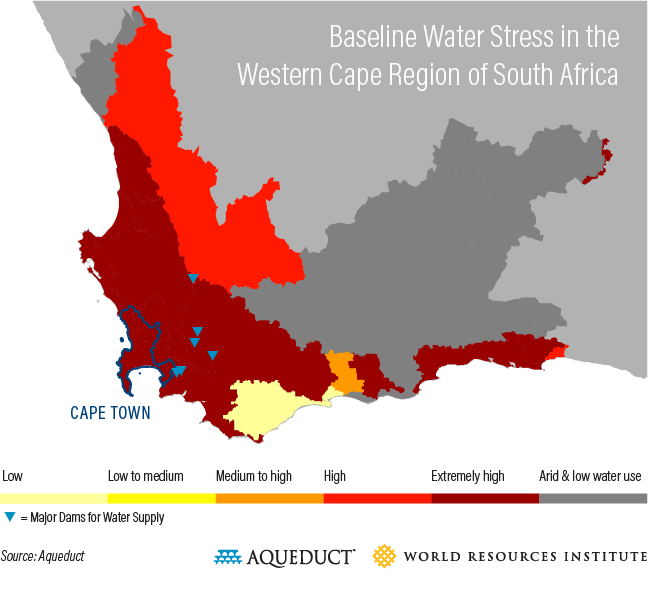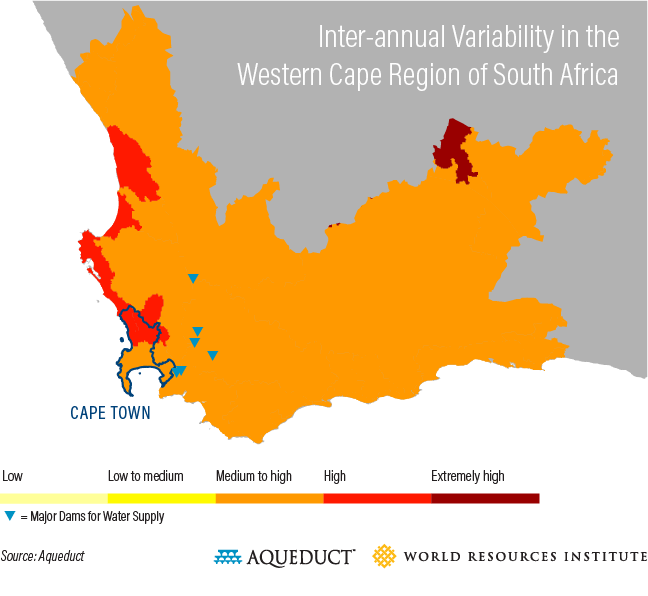3 Things Cities can Learn from Cape Town’s Impending “Day Zero” Water Shut-off
Published on by Water Network Research, Official research team of The Water Network in Academic
Here are three steps cities around the world should take to boost water security and resilience.
1. Understand risks
Many cities are experiencing growing water risks. Climate change is shifting cloud patterns and the hydrologic cycle in certain regions, making rainfall more variable and droughts more common and intense. At the same time, the world’s cities are growing at a rate of 3 million people per week, increasing competition over scarce resources.
Each city has unique risks it must be aware of. For example, Cape Town has medium-to-high inter-annual variability, meaning precipitation varies greatly from year to year. Although Cape Town has suffered droughts in the past, wet years usually follow, refilling reservoirs that supply the city with almost all of its water. But during the current record drought, reservoir levels have fallen to 25 percent.

In addition, Cape Town has extremely high water stress, which means that the water demands of its population – which has doubled in the past 18 years – are competing for the available water supply with other users. While city officials were aware of these risks and took steps to mitigate them, they did not anticipate rainfall patterns departing so significantly from the norm to culminate in record drought.

Amidst rapidly changing landscapes, cities like Cape Town must carefully measure and forecast the impacts of climate change, population growth and competing demands on their water systems. Tools like Aqueduct and The Nature Conservancy’s Urban Water Blueprint can help map the bigger picture, but risks will differ by watershed. Each city must ultimately assess its unique water risks and plan accordingly.
2. Manage your water budget
Cities have finite water resources, whether sourced from nearby watersheds, dams or pumped directly from underground. Where the water originates from differs by location—oftentimes a diverse set of users, such as power plants, farms and homes, compete for this same water. It’s a city’s job to manage its own water budget in the context of this broader landscape, understanding sources and uses, and allocating resources within these realities.
Water management becomes even more difficult in times of drought.
This controversial decision caused a great deal of debate in local politics, and is now seen as one of many culprits for the current crisis. This situation is common for many cities, but leaves them fighting with other sectors when water supplies decline.
One solution is for city planners and water utilities to undertake proactive, integrated urban water management strategies that consider drinking water, wastewater and urban drainage (stormwater) more comprehensively, helping cities to build greater resilience and efficiency.
This method also takes a holistic view of water sources and uses across a city, recognizing that the actions of every stakeholder impacts the others. Amid the nearly six-year California drought, the city of Los Angeles began developing a One Water plan to better manage limited water resources, stave off the impacts of climate change, and slash the city’s purchases of imported water by 50 percent.
3. Invest in resilience
To withstand a changing climate and growing populations, cities must be resilient to the unexpected. Identifying opportunities for rainwater harvesting, dams and underground storage, treating and reusing greywater and wastewater, and investing in water efficiency is key to boosting resilience to drought and increased water competition.
Cities should also look beyond their boundaries and invest in “natural infrastructure” for protection. Green spaces such as forests and wetlands can act as a sponge by shielding cities from floods and storms and regulating flow during dry seasons.
Research also shows that pairing natural infrastructure with traditional “grey” infrastructure like wastewater treatment plants can help cities create jobs, buffer against the impacts of climate change and save money on water treatment.
Inadequate built and natural infrastructure compounded the effects of São Paulo’s 2014-2017 drought. The city lost more than 30 percent of treated water through theft and leaky pipes. Deforestation of the Amazon disrupted the “rivers of the sky” that regulate rainfall across Brazil, and loss of nearby Atlas forests also destroyed local water systems.
São Paulo, Cape Town and other cities should consider natural infrastructure as one of many solutions for resilience to future water shocks.
A call to action for cities
The situation in Cape Town is unique in many ways, but there are common threads that tie it to São Paulo, Los Angeles, and cities around the world facing growing water risks. In the countdown to Day Zero, the South African national government and the City of Cape Town are working hard to help residents avoid the drought’s worst effects.
But other cities should also use this moment as a warning – without better water risk measurement, management and resilience, the next Day Zero could be coming to your corner of the world.
Source: Eco-Business
Media
Taxonomy
- Water Scarcity
- Water Supply
- Scarcity
- Water Supply
- Water Supply & Drainage